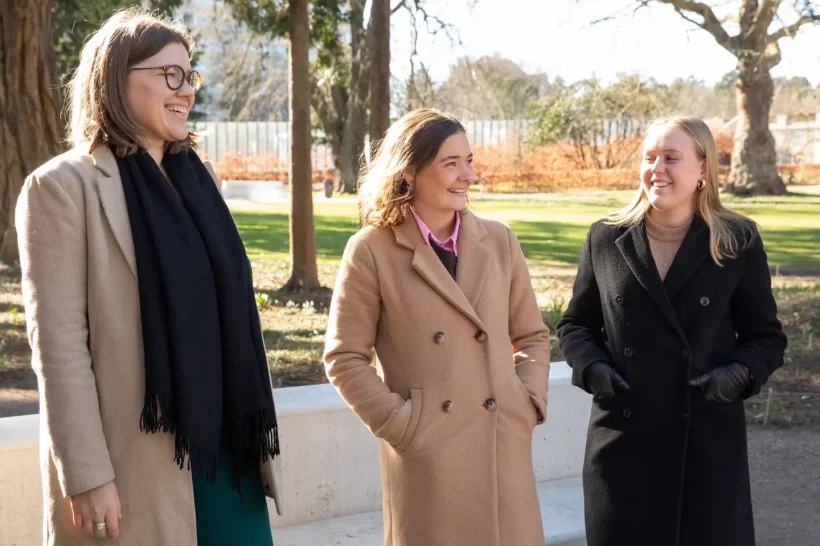Getting started with inclusive recruitment
We initiated our move toward inclusive recruitment by implementing a blind hiring software.
We were motivated primarily by our own experiences and a desire to improve our industry. Our managing partner, Christine Nordam, realised her biases were limiting the diversity of the company and wanted to make a change. Since our company values fairness and is fighting for new cultural norms in the finance and consulting industries, a blind hiring tool seemed like a natural next step.
At the time we had little understanding of the scope of inclusive recruitment, or the challenges it would bring. Blind hiring software was a clear solution to our identified problem.
What is blind hiring?
Blind hiring is the process of removing job applicant information that could potentially bring greater bias into the hiring process. Systems remove, or candidates are asked to leave out, information that is not relevant to the role, such as name, age, address, nationality, graduation dates, and headshots.
This information frequently correlates with or is used as a proxy for race, gender, wealth, age, or other demographics. Excluding it prevents biases related to these factors from becoming part of candidate review.
Without these personal details unnecessarily influencing initial assessments, application reviewers progress candidates to the next stages of the hiring process based solely on information relevant to the role. By removing information that is commonly associated with biases, individuals who are qualified but often discriminated against are more likely to progress to later stages of the hiring process.
The practicalities of blind hiring
We chose to use a tool that supports blind hiring by obscuring the personal details of applicants and asking them to complete games that assess their cognitive and behavioural traits. Since general mental ability is the most significant predictor of future job performance, these assessments can help us to find candidates who will meet our needs.
While the tool we use allows us to ask about work history and educational background, we try to limit the questions we ask as well as our use of this information. After all, education is a terrible predictor of future job success.
Other companies implement blind hiring by using various speciality software options, requesting that candidates leave off specific information, or using other DIY strategies.
From blind hiring to inclusive recruitment
While blind hiring had initially seemed like a quick fix, our implementation of blind hiring software opened the door to a much larger conversation about inclusive recruitment. Once we started to discuss our hiring practices, we learned that structural barriers exist throughout the recruitment pipeline.
We then researched and implemented changes that were realistic for our company and could further our aims.
These efforts have yielded some initial success. Although our sample size is still small, we have seen an increase in the number of nationalities who apply, greater diversity in the educational institutions attended by applicants, and a more even gender distribution among candidates who are interviewed.
To support our goal of diverse candidates and achieve these initial results, we revisited the key stages of our hiring processes.
Inclusion starts with the job ad
The language in job ads can limit who applies, so we check our ads for coded language and ask many members of our team to review the description ahead of time. This tactic has its limitations, but it is a practical approach that allows us to make sure that our listing is clear and that people of multiple ages, education levels, genders, and backgrounds can understand the role.
Marketing expands the talent pool
We also recognised that sharing the job ad only with our existing network and followers inherently limits the potential for inclusive recruitment. We shared our next open role in a broader range of locations to increase the diversity of our pipeline.
In addition to expanding the number of public job boards we used, we also posted the role in social media groups and sent it to universities. Our approach was limited some due to our budget, but we received a larger pool of applicants and invited a more diverse group to interview by initially casting a wider net.
Interviewing is inherently biased
We revisited our interview practices to reduce the role of individual biases in our decisions. By implementing structured interviews, we ensure that candidates meet our needs and that no single person’s bias drives our hiring.
First, we determine who will be part of hiring for the role. Because interviewing is inherently biased, we always use at least two interviewers in each conversation, but there may be others involved in defining the role. The team establishes clear criteria for success in the role and develops corresponding questions. Then our interviewers consider what elements are necessary in each response to be considered a high performing, moderate, or low performing response.
Following the interview, the interviewers independently assess the candidate based on the predetermined criteria. Completing this step separately ensures that they bring their own perspectives and can challenge each other’s biases when they come back together to discuss their assessments using the established framework.
This approach requires our team to clearly identify upfront what they are looking for from the candidates and to assess every interviewee according to those same criteria.
While no interview process is truly unbiased, this strategy limits the role a personal affinity toward a single candidate can play in the process.
Inclusive recruitment brings its own challenges
Our adoption of inclusive recruitment practices has also spurred new conversations about recruiting, diversity, and our priorities. While we initially set out with a full commitment to blind hiring, over time we asked whether inclusive hiring really serves our needs.
For us, the answer is sometimes.
Networks are not blind
One of the core challenges of our business is that it is primarily network driven. Our clients are thinking about or working toward a transaction in secret, and only their inner-most circle knows about it. When they are ready for expertise, they look for an advisor they can trust. Accordingly, personal referrals are an essential element of how we acquire new clients.
Since our business is highly reliant on networks, we want employees with strong networks. This is especially important for mid to high level roles who have some responsibility to bring in or manage clients. In these cases, the network may be as or more important than skills because we know that most skills can be taught.
But blind hiring does not allow us to ask about or understand a candidate’s network. If we do not know who a candidate is, we cannot understand who they know, how they know them, or whether their network will be useful to us.
Perception is key
Although we know that education holds little value in assessing job performance, we also know that perception is important. Certain universities and degree types are generally received more positively and can lend credibility to individuals with those names on their CV.
Similarly, we recognise the that some work histories can bring a perception of expertise or credibility. Again, it is often impossible to assess ahead of time whether any given individual actually matches that perception. Plenty of people do mediocre work at well-known firms, just as others do stellar work at unknown firms.
But perception is key. Especially in our network-driven business.
Regardless of their legitimacy, positive judgements about our team are core to our success in offering knowledge-based services. A highly prized degree or experience from a known company can be the thing that encourages someone to take the leap and work with us.
Yet we know that this practice is self-perpetuating. The more we share “high value” education and work history information, the more we give it credence. So how can we convince potential clients that our team is superior without buying into these faulty assumptions?
We will let you know when we figure it out.
Internal education is a commitment
As a small and relatively new company, we did not have ingrained organisational norms, but we still faced the challenge of educating our team about the reasoning and practicalities of inclusive recruitment. Our team has used or experienced other strategies when hiring or applying for jobs in the past, and we needed to have explicit conversations about what our process would look like.
These are fascinating and challenging conversations that help us all to grow, but they are a commitment. Time spent on recruitment, either actual hiring or theoretical discussions, is time that cannot be spent elsewhere.
Applicants expect culturally normative practices
While most applicants have a positive response to the concept of blind hiring, it is clear that we are asking for a cultural change from job applicants too.
Job searchers often call or email to convey their interest (as is normal in Denmark) and are disappointed when they learn that we cannot tie the conversation to their application. While we are happy to answer questions about the role and our team, blinded applications mean we are unable to give an advantage consciously or subconsciously to applicants with whom we have spoken.
And though most applicants respond positively to our neuroscientific games, a few applicants have communicated that they disagree with their results. We try to address these concerns with information about how we use the results, but we recognise that no hiring approach will make everyone happy.
We view these challenges as a reminder of how ingrained our traditional practices are in society. With time, less-biased processes may become normalised. For now, cultural hurdles encourage us to push forward with inclusive practices.
Blind hiring is not free
We chose software because we are a small team with limited time and little expertise in blind hiring. However, the financial costs of this software are notable for us because of the low frequency with which we hire. Our software has a fixed monthly cost, and we pay for it regardless of whether we use it.
While we could pursue a DIY route, this demands a significant time investment. Employees are responsible for redacting names, sorting applicants, designing an efficient workflow, and otherwise implementing and facilitating the DIY approach. Time is money, and our small team’s time is better spent on client projects and sales-focused internal work.
Our pragmatic approach to inclusive recruitment
While we would love to hire solely through blind applications within an inclusive process, these challenges mean it is not realistic for our business at this time. We are working to expand our brand and reduce our reliance on personal networks, but networking will be an essential piece of our business for the foreseeable future.
So long as networking is essential, we will look for employees with strong networks and easily saleable education or work history.
As a result, we set a goal to use blind hiring for more than 50% of our hires in our 2023 financial year. This requires us to use blind hiring for roles where network is not essential, but still provides the flexibility we need to hire some roles based on network and other factors. With a target in place, we now discuss whether a role should be blinded and make an educated decision about the trade-offs of each approach.
We will reassess this target annually to make sure it aligns with our business needs. In the future, we hope to increase the percentage of hires coming through our inclusive recruitment process.
Moving forward with inclusive recruitment
We now recognise inclusive recruitment as the ongoing commitment that it is. We are proud of the progress we have made, but aware that there is plenty of room to grow.
Small steps add up, and we encourage companies of all sizes to commit to action where they can. We often recommend that clients include an external individual in the hiring committee. Bringing an outsider to help assess candidates is an easy first step that can make sure that another perspective is considered. Other incremental changes, like asking candidates to leave photos off their CVs or establishing clearly defined criteria for each role before reviewing applications, can make a difference.
We have taken this incremental approach ourselves. Our progress may be imperfect, but we know it is better to start somewhere than not to start at all. Getting started and learning from our mistakes is the best way to move the conversation, and our norms, forward.
And now, the real inclusion work starts. With improved diversity, we must work even harder to create a culture that includes, supports, empowers, and retains the diverse perspectives and needs of our workforce.












